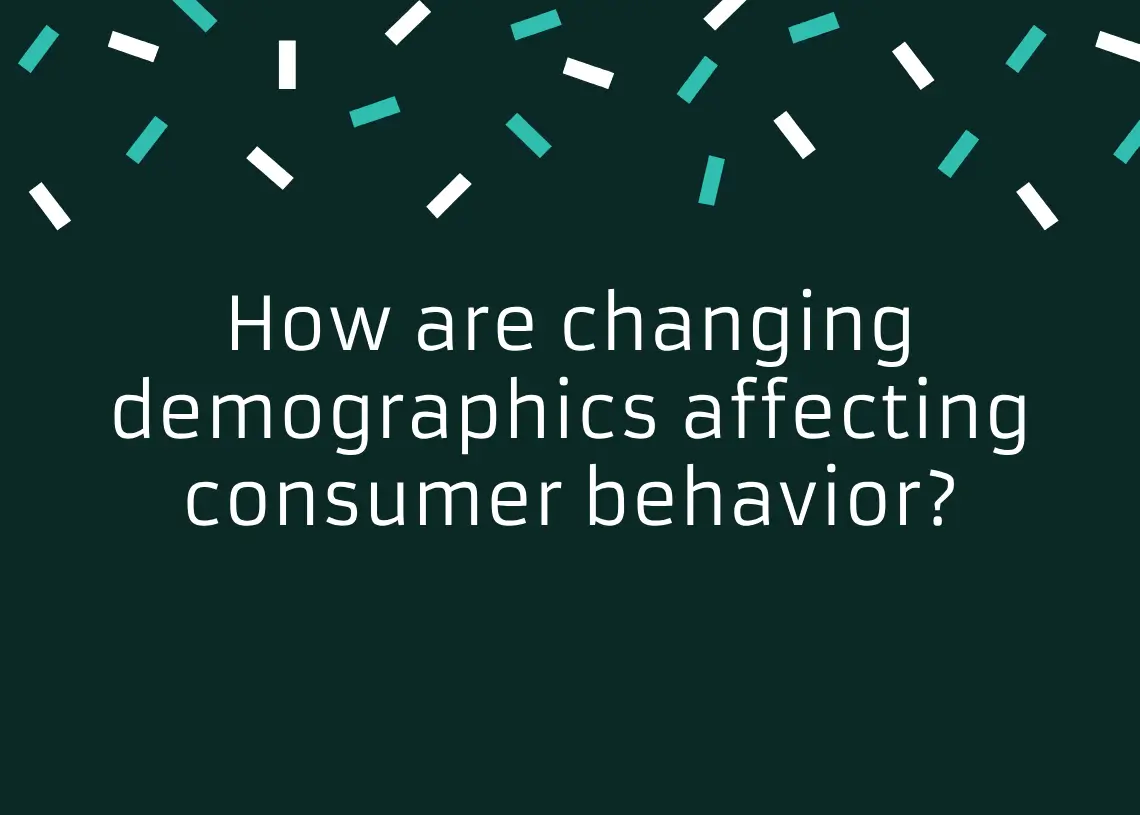As the world continues to evolve and become more complex, so do the demographics of its inhabitants. From varying age groups and cultural backgrounds to changing societal norms and economic conditions, these factors have a profound impact on the way consumers interact with products and services. Understanding how changing demographics affect consumer behavior is a critical component to creating effective marketing strategies that resonate with your target audience.
In today’s blog post, we will delve into the topic of how changing demographics are affecting consumer behavior. We will explore some of the key trends and insights that are driving this change and what businesses can do to stay ahead of the curve. We’ll examine how changing age demographics are dictating the types of products and services that appeal to various generations and how cultural differences are shaping consumer preferences.
We’ll also touch on the impact of technological advancements on consumer behavior and how these trends are set to change in the coming years. Whether you’re a marketer, business owner, or simply curious about the trends shaping today’s consumer landscape, this post is for you.
Earn a certificate in your dream career for an affordable price at IAP Career College today!
Aging population demands new products
The aging population is one of the most significant demographic shifts affecting consumer behavior today, and it demands the creation of new products. This demographic group is growing rapidly, with more individuals reaching retirement age and beyond. As they age, their needs and preferences change, and businesses need to adapt to meet these evolving demands.
For example, the elderly often require products that are easier to use, more accessible, and provide greater convenience. Additionally, health and wellness become increasingly important concerns, with a focus on products that support physical and mental wellbeing. As a result, companies need to prioritize research and development efforts that focus on creating products that cater to the needs of older consumers. Failure to do so will result in missed opportunities and lost revenue.
Diversity influences market segmentation
The impact of changing demographics on consumer behavior is a significant topic in the business world. One aspect of this impact is the influence of diversity on market segmentation. In today’s world, there is a growing emphasis on diversity in all aspects of society, including in consumer markets.
The increased diversity in society has resulted in a more complex market segmentation, as companies try to provide products and services that cater to different cultural groups. Companies that fail to recognize the importance of diversity in market segmentation risk losing out on potential customers. Therefore, it is crucial for businesses to understand and adapt to the changing demographics of their target markets in order to remain competitive and successful.
Millennial values impact brand loyalty.
One of the significant demographic shifts that have impacted consumer behavior is the rise of millennials as a dominant consumer group. This generation, born between 1981 and 1996, has different values and priorities than previous generations, and this has translated into their shopping habits and brand loyalty. Studies have shown that millennials are more likely to support brands that align with their values and beliefs, such as sustainability, social responsibility, and ethical practices.
They are also more likely to switch brands if they perceive a company as not living up to these values. Therefore, companies must be aware of millennial values and incorporate them into their marketing strategies to build brand loyalty among this influential demographic.
Gen Z embraces social responsibility.
As we explore how changing demographics are affecting consumer behavior, one trend that has emerged is the embrace of social responsibility by Generation Z. This demographic cohort, born between the mid-1990s and early 2010s, has grown up in a world where social issues such as climate change, income inequality, and racial justice are at the forefront of public discourse.
As a result, Gen Z consumers are increasingly seeking out brands that align with their values and take a stand on issues they care about. This includes supporting environmentally conscious practices, promoting diversity and inclusion, and advocating for social justice causes. Brands that fail to embrace social responsibility risk losing the loyalty of this influential consumer group, as Gen Z consumers are quick to call out and boycott companies that do not align with their values. Companies that understand and embrace the values of Gen Z will be better positioned to succeed in the marketplace of the future.
Women shift purchasing power dynamics
Changing demographics are having a significant impact on consumer behavior, and one of the most notable shifts is the increasing purchasing power of women. Women are becoming an increasingly important demographic in the marketplace, with more financial independence and decision-making power than ever before.
This shift is being driven by a number of factors, including the rise of female entrepreneurship, changing social norms, and increased access to education and employment opportunities. As a result, businesses that fail to recognize and respond to the changing needs and preferences of female consumers risk losing out on a significant segment of the market. Companies that can successfully cater to the needs of women and build meaningful relationships with this demographic are likely to see increased sales and long-term success.
Rural and urban divide affects trends.
The rural and urban divide is a significant factor in influencing consumer behavior trends. While urban areas tend to have higher levels of income, education, and access to technology, rural areas often have limited options in terms of products and services. This divide affects consumer behavior in various ways. For instance, rural consumers may have limited access to e-commerce services, which in turn affects their online purchasing habits.
On the other hand, urban consumers have access to a wider range of products and services that may not be available in rural areas. As a result, they are more likely to engage in experiences such as dining out, attending cultural events, and travel. Understanding the impact of the rural and urban divide is essential for businesses to tailor their products and services to meet the unique needs and preferences of different consumers.
Multiculturalism alters advertising strategies.
One of the most significant ways in which changing demographics are affecting consumer behavior is through the rise of multiculturalism and its impact on advertising strategies. As the population becomes increasingly diverse, traditional advertising methods are no longer as effective as they once were. Companies must now consider the cultural backgrounds and values of their target audience to create marketing campaigns that resonate with them.
This means incorporating diverse imagery, language, and cultural references into advertisements to avoid alienating potential customers. Additionally, companies must ensure their messaging is inclusive and appeals to a wide range of cultural backgrounds, as consumers are becoming more conscious of diversity and representation in advertising. Overall, multiculturalism is forcing companies to rethink their advertising strategies and adapt to meet the changing demographic landscape.
E-commerce caters to busy lifestyles.
Changing demographics are having a great impact on consumer behavior. One of the notable shifts is the increasing demand for e-commerce, which caters to busy lifestyles. In today’s fast-paced world, consumers are looking for convenient and time-saving ways to shop. E-commerce allows shoppers to browse and purchase products at any time from the comfort of their own homes.
This trend is particularly popular among millennials, who are known for their busy schedules and love for technology. Retailers who want to stay competitive must adapt to this changing landscape and provide a seamless online shopping experience that meets the needs of their customers. By embracing e-commerce, retailers can tap into a growing market of consumers who prioritize convenience and time-saving solutions.
Health concerns shape product preferences.
One of the most significant ways that changing demographics are affecting consumer behavior is through health concerns shaping product preferences. As people become more health-conscious, they are paying closer attention to the ingredients and quality of the products they buy. For example, younger generations are increasingly concerned about the environmental impact of their food choices and are opting for plant-based and organic options.
Additionally, older generations are looking for products that can help them manage health conditions or prevent age-related issues. This has led to an increase in demand for products like vitamins, supplements, and functional foods and beverages that offer specific health benefits. As a result, companies that cater to these changing preferences are seeing growth opportunities in the market. Understanding these evolving health concerns and adjusting product offerings accordingly can help companies stay relevant and competitive in today’s market.
Personalization becomes increasingly important.
One of the key trends that we have observed in changing consumer behavior is the increasing importance of personalization. As the demographic landscape evolves, consumers are becoming more diverse in their preferences and needs. This means that businesses must adapt their marketing strategies to cater to the unique requirements of each individual customer.
Personalization can take many forms, from personalized recommendations based on purchase history to customized messaging and offers that are tailored to the customer’s interests. As a result, companies that invest in personalization are likely to see higher levels of customer engagement and loyalty, as well as increased sales and revenue. However, it is important to note that personalization must be done in a way that respects customer privacy and preferences, and that companies must be transparent about their data collection and usage practices.
Conclusion: How are changing demographics affecting consumer behavior?
In conclusion, changing demographics are having a significant impact on consumer behavior. As the population becomes more diverse, companies and marketers must adapt their strategies to appeal to a wider range of consumers. By understanding the unique needs and preferences of different demographic groups, businesses can create more tailored products and services that better meet the evolving demands of their customers. As demographics continue to shift, it will be crucial for companies to stay abreast of these changes and adjust their marketing and business practices accordingly in order to remain competitive in the marketplace.




